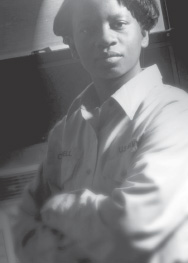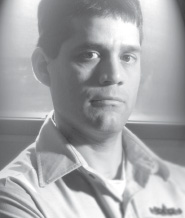A Sailor's History of the U.S. Navy (24 page)
Read A Sailor's History of the U.S. Navy Online
Authors: Thomas J. Cutler

Hull Maintenance Technician Second Class Chris Regal was standing in an after passageway near the flight deck when he was abruptly slammed to the deck. Nearly knocked unconscious, he was aware of a great pressure change inside the ship. Shaking his head like a boxer who has just taken a jolting left hook, he climbed to his feet and began running toward the source of the detonation.
Petty Officer Third Class Tayinikia Campbell, a twenty-four-year-old hospital corpsman from Latta, South Carolina, had joined the Navy six years earlier, right out of high school. Because she was the junior corpsman in
Cole,
in addition to not being very big, the crew had christened her “Baby Doc.” She was in sick bay, working with her striker Seaman Eben Sanchez, when the doors blew open “like someone had kicked them in,” and thick black smoke poured into sick bay. Campbell and Sanchez could hear voices frantically calling, “We need Doc,” and the two of them ran down the passageway toward the calls. Finding injured shipmates all about, they set up a makeshift aid station there in the passageway and began treating the many wounded. The longest day in Baby Doc's life had just begun.
The fanatics had driven their boat into
Cole
's port side amidships. This time they had done all their homeworkâthe shaped charge of powerful explosives had detonated with great force, tearing a forty-by-forty-foot hole in the destroyer's side, smashing in bulkheads, and tearing deck plating as though it were made of paper. Smoke filled her passageways, and water was already pouring into her engineering spaces. Dozens of
Cole
's crew had been killed or injured in the blast. In an instant, the many ranks, ratings, and other distinctions in the complex crew of this billion-dollar ship were of little relevance. As a
Navy Times
article would later observe, just three jobs mattered now, and every able-bodied crew member would soon be performing one of them: caring for the injured, providing security against further attack, and saving the ship.
The ship was already listing to port, a sure sign she was suffering major flooding. All power was lost; torn electrical cables dangled from overheads, arcing and sparking dangerously close to fuel that gushed out of ripped fuel tanks and coated everything in its path. A portion of the deck in the mess decks area had been rolled up like the lid of an opened sardine canâprotruding from the roll, four boots could be seen. One badly injured Sailor was placed on a door as a makeshift stretcher for evacuation. Injured Sailors tended to shipmates who were more seriously injured. Others opened canisters of fire-fighting foam concentrate and poured the yellow liquid onto the fuel-covered decks in hopes of preventing ignition.

The 12 October 2000 terrorist attack on USS
Cole
as she was refueling in Aden harbor tore a forty-by-forty-foot hole in the destroyer's port side.
U.S. Navy (Lyle G. Becker)
In the oil lab one deck below the chief's mess, Gas Turbine Technician Mechanical First Class Margaret Lopez could see daylight through a jagged hole in the ship's side. Water streamed in through the hole and choking smoke made breathing difficult. She had been seriously burned over twenty percent of her body. Looking about she soon realized that she and another Sailor were trapped in the space; crushed bulkheads had sealed them in.
Helping her shipmate, she waded into the flowing water and fuel and got both of them out through the jagged hole and into the gulf waters. She then swam back into the ship in search of a missing shipmate. Exploring the internal wreckage, she was unable to find him and eventually went back out into the harbor and swam alongside the side of the ship until some Sailors on the main deck hauled her aboard.
Shortly after the explosion, Hull Maintenance Technician First Class Michael Hayes made his way to the mess decks areaâor what was left of it. With several other shipmates, he ventured into the surreal world of death and destruction, stepping over a puddle of boiling water to get there. In his fifteen years in the Navy, he had never seen anything like this. It was pitch dark except for the strobing lights of arcing electrical wires. Smoke filled the compartment, muffling sound and softening what images there were as though they were part of a dream sequence in a movie. There was an acrid taste in his mouth that he had experienced many times before in training, but there was something different about it this time.
Hayes donned a damage control helmet with a light on it so he could see through the haze. He did not need his years of experience and training in damage control to tell that the ship was in bad shape. The damage to this area was extensive, making almost unrecognizable what had been a familiar area where he and his shipmates had shared meals and talked about the things Sailors always talk about when deployed to far-off parts of the world. Struggling through the massive wreckage, he began to sort among the human beings who were scattered about, passing by those who were obviously gone and tending to the injured. Some Sailors were trapped beneath equipment, so Hayes made his way to a repair locker and returned with several crowbars to dislodge the equipment and extract the victims. With a number of others, including Ensign Kyle Turnerâwhom Hayes would later describe as being “everywhere”âhe helped carry or drag many of the injured to the relative safety of adjoining passageways.
Petty Officers Regal and Garcia had teamed up and were moving toward the source of smoke that filled the portside passageway. The lights were out, but emergency battle lanterns lit their way. In the half-light, Regal nearly bumped into an electrical panel that was sparking a deadly warning; Garcia saw it in time and shoved his shipmate away from the danger. When they reached the mess decks, they saw that there was no deck left on the port side. Both men entered the space and began the hardest work of their lives.
Regal formed a team of Sailors and moved forward to see how far the damage extended and to render assistance to those who might be trapped up there. Garcia remained on the shattered mess deck, helping a chief petty officer out of a hole he had fallen into and then comforting a Sailor while others used a “jaws of life” to extract her from twisted wreckage. Regal returned from his foray forward, and he and others muscled a partition away from a number of injured chiefs who were trapped by it in their mess. Although injured himself, Chief Boatswain's Mate Eric Kafka immediately began helping those more seriously wounded.
At makeshift triage stations Baby Doc, Sanchez, Parlier (whose rating had been hospital corpsman before he became command master chief), and
Cole
's independent duty corpsman, Chief Clifford “Doc” Moser, worked frantically to save the worst cases while directing the efforts of the uninjured and less-injured Sailors who worked on broken bones and jaws, bleeding wounds, crushed arms and legs, and various other injuries. Makeshift splints were rigged, shirts were made into bandages, and words of encouragement were whispered into shipmates' ears.
Those who were not caring for the wounded were caring for their ship, doing everything in their power to save her. The destroyer had been dealt a devastating blow, and she was in grave danger of going to the bottom. As an indicator of how serious the situation was, divers would later report that a sixty-foot crater had been carved out of the bottom by the powerful blast. But it was the gaping hole in the ship's side that was the potential mortal wound unless these Sailors could contain the damage and stop the reverse bleeding as tons of water poured in.
Using the tried and true methods of damage control they had been trained in since boot camp, Sailors shored up weakened bulkheads, filled holes, and set up barriers to prevent progressive flooding. Because they had no power to the pumps, they set up portable pumps where possible. Other Sailors formed a “bucket brigade” by lining up and passing scrub buckets, wastebaskets, and garbage pails from one to another to remove the water.

HM3 Tayinikia “Baby Doc” Campbell, along with the other corpsmen in USS
Cole,
set up makeshift triage stations to care for the many wounded.
U.S. Navy Photo. Courtesy of
All Hands
magazine
When all the wounded had been cleared from the mess decks area, Hayes and Garcia teamed up in Auxiliary Machinery Room #1 to repair a ruptured pipe that was allowing fuel and water to pour into the ship's bleed air system. When that was done, the two moved to Auxiliary Machinery Room #2 to control the flooding there.
For hours, the battle to save
Cole
went on. Many of these young people had grown up thinking of “blood, sweat, and tears” as a rock group from an earlier time; now, as they tended to horrific injuries, labored in oppressive heat to accomplish gargantuan tasks, and said farewell to fallen shipmates, those words had new meaning.
As the sun began to disappear below the horizon,
Cole
's skipper, Commander Kirk Lippold, met with the crew on the fantail. Standing before him were Sailors covered with oil, soot, all manner of dirt, and bloodâsome their own, some their shipmates'. Their faces showed they were utterly drained by their ordeal, yet all knew this trial was not over. Lippold's words are unrecorded, but they were the words between a captain and his crew, trying to express the inexpressible, spoken from deep within a human soul to other souls who have experienced the unthinkable, who have witnessed the unconscionable, who have learned within a few hours what is worst and what is best in mankind. He later summed it up by describing these men and women as “one crew in one moment in time who rose to a challenge no crew should ever have to face.”

Damage Controlman First Class (SW) Ernesto Garcia labored in the mangled mess decks area of the
Cole,
helping injured shipmates and clearing away tangles of debris.
U.S. Navy Photo. Courtesy of
All Hands
magazine
The next few days were exhausting ones for the crew of USS
Cole.
With little time for food, rest, or even much reflection, they worked constantly to keep their ship afloat and to restore the vital functions that would make their ship the living organism she had been before the attack. Through a gargantuan effort, the men and women of this stricken ship resuscitated her by calling upon their training, their sense of duty, their upbringing, their anger, and most of all, their devotion to each other. They rigged pumps and kept them running in a constant battle with the intrusive sea. They removed debris and cleaned up fuel. They defanged the snakes of electrical cabling that dangled dangerously from the overheads. They built makeshift bridges across gaping holes and cut away jagged metal.
By Saturday night, two and a half days after the attack, most were convinced that the battle was being won, that
Cole
would stay afloat and not give her enemies the satisfaction of seeing her surrender to the devastation they had unleashed. Then the ship suffered a major setback that once again put the matter in grave doubt and threatened the loss of an American warship to enemy action, the first in a very long time.